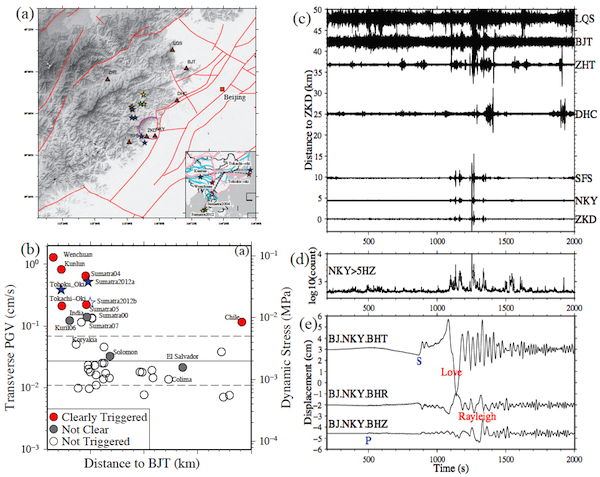2012 IRIS Workshop
Comparisons of dynamic triggering near Beijing, China following the recent Sumatra earthquakes
Jing Wu: CAS, Zhigang Peng: GT, Weijun Wang: CEA, Xuan Gong: CEA, Qi-Fu Chen: CAS, Chunquan Wu: LANL
(a) Locations of triggered events around the Fangshan Pluton near Beijing, China. (b) Vertical peak ground velocity (PGV) and the corresponding dynamic stresplotted plotted against epicentral distance at station BJT. The blue solid and open stars mark the 2012 Mw8.6 and 8.2 Sumatra earthquakes, respectively. (c) A record section of 5 Hz high-pass-filtered waveform showing triggered signals. (d) Envelope function and (e) three-component broadband displacement seismograms at NKY.

Full-resolution graphics file in original format: 0126.png
Dynamic triggering around the Fangshan Pluton near Beijing is repeatedly identified from our previous studies (Wu et al., 2011; Wang et al., 2011). The triggered events are shown as clear P and S waves in 5 Hz high-pass-filtered seismograms during the passage of surface waves with large peak ground velocities (PGVs) > 0.1 cm/s for the following teleseismic earthquakes: 2001 Mw7.8 Kunlun, 2003 Mw8.3 Tokachi-Oki, 2004 Mw9.2 Sumatra, 2008 Mw7.9 Wenchuan, 2010 Mw8.8 Chile, and 2011 Mw9.0 Tohoku-Oki earthquakes. Here we report clear triggered events during the surface waves of 2012 Mw8.6 Sumatra earthquake around the Fangshan Pluton. So far we have identified five triggered events recorded by four stations with clear P and S waves. These triggered events are located near the Fangshan Pluton, with magnitude 1~2, and depth mainly above 5 km, consistent with our previous studies. However, we did not identify any triggered events during the Mw8.2 Sumatra earthquake that occurred two hours later, even though the measured PGV is around 0.2 cm/s. The fact that the first 2002 Sumatra earthquake triggered but not the second one motivated us to re-examine the triggering behavior around the Fangshan Pluton following previous large earthquakes occurred in Sumatra since 2004. We find that the 2005 Mw8.6 Nias earthquake produced smaller PGVs than the two 2012 Sumatra earthquakes, despite its large magnitude. However, the Nias earthquake appeared to trigger small-amplitude events that were only recorded at station NKY. These preliminary results suggest a variable triggering behavior that depends not only on the PGVs of the incoming surface waves but also the time since previously triggered earthquakes. Our next step is to systematically examine the seismic records near Fangshan for other Sumatra earthquakes, and use them to better understand the physical mechanisms and necessary conditions for dynamic triggering in intraplate regions.
Acknoweldgements: Acknowledgements: This work was supported by the National Science Foundation EAR-0956051 and National Science Foundation of China grant no-41074037.
For further reading: Wang, W., X. Gong, Z. Peng, Q. Chen, and C. Wu (2011), Dynamic triggering around Fangshan Pluton near Beijing, China, Abstract S22B-06 presented at 2011 Fall Meeting, AGU, San Francisco, Calif., 5-9 Dec. Wu, C., Z. Peng, W. Wang, and Q.-F. Chen (2011), Dynamic triggering of shallow earthquakes near Beijing, China, Geophys. J. Int., 185, 1321–1334. doi: 10.1111/j.1365-246X.2011.05002.x
Keywords: triggered_earthquake, beijing, sumatra_earthquake
